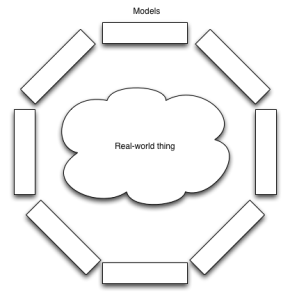On the 4th December 2013, I said:
Do you have any idea how much work that is? I do, now. So I’m going to cover a very small part of the story here, with a view—your interest and my inclination permitting—to adding to it in subsequent posts.
Part One: you’ve lost your thing
The genesis of MVC comes in 1979 with a pair of memos written by Trygve Reenskaug of the Xerox Learning Research Group. In the first, A Note on Dynabook Requirements, Reenskaug documents an approach to tackling problems in the Smalltalk environment by describing his design for a project management task.
A fun digression at this point is the observation that Reenskaug appears to have described what we now call the user story: a goal-directed statement of what someone’s trying to achieve, as a replacement for a specification of what some theoretical software product should do.
Most problems would start with a rather unclear and often self-contradictory goal. Some examples: I would like to get better control over my finances; I don’t want to be troubled with detailed accounting; I want to settle my account with the butcher; I want to know more about Tarot cards; or I want a small, cheap house with many large, luxurious rooms.
I would expect the user to go more or less subconsciously through a goal-means hierarchy: Certain means are needed to reach a given goal. These means are not immediately available, but constitute a new set of part-goals, each of which needs certain means for their satisfaction, and so on.
An example: To get better control over my finances, I would need to set up a budget; to keep account of all income and expenditure; and to keep a running comparison between budget and accounts. Three new, non-trivial goals that need further consideration.
He goes on to note that given a sufficiently consistent collection of goals, the computer should probably just solve the problem itself. In the absence of evidence that this is possible (Prolog notwithstanding), we’ll need to tell the computer the methods by which the problem is solved.
Anyway, back to MVC. The solution in the context of his project management problem then follows. Along the way he introduces some metaphors that are formalised in a glossary in the second memo, called not Model-View-Controller but Thing-Model-View-Editor: an Example from a planningsystem.
An immediate observation is that where MVC has three parts, TMVE has four: the thing being modelled is explicitly part of the problem. MVC is a way to do computer stuff, TVME is a way to use a computer stuff to solve a problem based in the real world. Of course, you cannot put the thing itself inside the computer, except in the world of Tron which was yet to be released. So instead you find some useful abstraction and represent it in the computer as a model. This model contains both the data and the actions appropriate to the abstraction it represents.
The image below, an adaptation of a figure that appears in both documents, demonstrates that a nebulous thing can be modelled by multiple different abstractions, or that multiple models can represent different parts of the thing.
Now for any model, there will be one or more views that represent the model in a meaningful way; models do not know how to draw or print themselves. Views can also control the model in ways appropriate to the view’s representation. For example, Reenskaug shows that a view describing a model’s properties could accept changes to those properties, and make the required changes to the model.
Now there’s going to be a complicated object graph in place, with one or more model objects each represented by one or more views, all to solve a problem with one particular thing. The editor is a coordinator for all of these. It acts as a command interface, mediating between the user and this network of objects. As changes are made, the editor coordinates with all of the views.
You will recall that Trygve Reenskaug was on the Learning Research Group at Xerox. A Smalltalk system like the proposed Dynabook is supposed to be a computer that lets people solve their own problems, by being easy to program and to manipulate. Therefore, unlike modern MVC which is a design tool for professional programmers, Thing-Model-View-Editor is a user interface paradigm, describing how people can build their own programs to solve their own problems. The editor may have a doit command to send Smalltalk messages, but sending Smalltalk messages should not be beyond the wit of an interested and engaged user.
This goes some of the way to explaining why “computery stuff” like persistence, networking and the like are not tackled in TVME. They are outside its purview: the computer should be looking after that stuff. Just as the humane interface on a Canon Cat has no save or load buttons, and the computer looks after storage itself, so Dynabooks do not have databases, or filesystems, or memory allocators. These are abstractions of the thing “computer”, but Thing-Model-View-Editor is concerned with the thing that people want to represent in the computer. The computer is not the thing.



Pingback: Model View Whatever | Khanlou.com
Pingback: Empowered free software – Structure and Interpretation of Computer Programmers